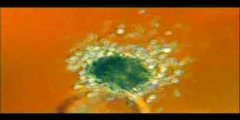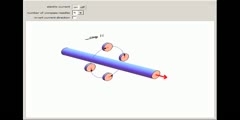Lec 12 - The Creation of an Icon: The Colosseum and Contemporary Architecture in Rome
"Lec 12 - The Creation of an Icon: The Colosseum and Contemporary Architecture in Rome" Roman Architecture (HSAR 252) Professor Kleiner features the tumultuous year of 68-69 when Rome had four competing emperors. Vespasian emerged the victor, founded the Flavian dynasty, and was succeeded by his sons, Titus and Domitian. The Flavians were especially adept at using architecture to shape public policy. Professor Kleiner demonstrates that Vespasian linked himself with the divine Claudius by completing the Claudianum and distanced himself from Nero by razing the Domus Aurea to the ground and filling in the palace's artificial lake. In that location, Vespasian built the Flavian Amphitheater, nicknamed the Colosseum, thereby returning to the people land earlier stolen by Nero. Professor Kleiner discusses the technical and aesthetic features of the Colosseum at length, and surveys Vespasian's Forum Pacis and Titus' Temple to Divine Vespasian. The lecture concludes with the Baths of Titus, Rome's first preserved example of the so-called "imperial bath type" because of its grand scale, axiality, and symmetry. 00:00 - Chapter 1. The Year 68-69 and The Founding of the Flavian Dynasty 11:42 - Chapter 2. The Claudianum or The Temple of Divine Claudius 19:52 - Chapter 3. The Colosseum: Icon of Rome 33:17 - Chapter 4. The Colosseum as a Post-Antique Quarry 44:30 - Chapter 5. The Forum or Templum Pacis 01:01:39 - Chapter 6. The Imperial Baths of Titus Complete course materials are available at the Open Yale Courses website: http://open.yale.edu/courses This course was recorded in Spring 2009.
Video is embedded from external source so embedding is not available.
Video is embedded from external source so download is not available.
Channels: Others
Tags: Lec 12 - The Creation of an Icon: The Colosseum and Contemporary Architecture in Rome
Uploaded by: yalearchitecture ( Send Message ) on 12-09-2012.
Duration: 72m 14s
Here is the next lecture for this course
Lec 14 - The Mother of All Forums: Civic ...
01:11:33 | 2689 viewsLec 1 - Introduction to Roman Architecture
42:31 | 3035 viewsLec 15 - Rome and a Villa: Hadrian's Pant ...
01:13:24 | 2345 viewsLec 2 - It Takes a City: The Founding of ...
01:14:27 | 2703 viewsLec 3 - Technology and Revolution in Roma ...
01:10:49 | 2428 viewsLec 9 - From Brick to Marble: Augustus As ...
01:15:03 | 2531 viewsLec 16 - The Roman Way of Life and Death ...
01:16:09 | 3126 viewsLec 17 - Bigger Is Better: The Baths of C ...
01:15:37 | 2561 viewsThe miracle of man's creation part 2
18:36 | 8552 viewsPERFECT CREATION OF THE SKELETON 2
00:00 | 6223 viewsCreation of a Magnetic Field by an Electr ...
00:07 | 7767 viewsLec 1 - MIT 4.125 Architecture Studio: Bu ...
11:35 | 2510 viewsLec 2 - MIT 4.125 Architecture Studio: Bu ...
17:57 | 2445 viewsLec 3 - MIT 4.125 Architecture Studio: Bu ...
12:37 | 2303 viewsLec 4 - MIT 4.125 Architecture Studio: Bu ...
18:05 | 2224 viewsNo content is added to this lecture.
This video is a part of a lecture series from of Yale
Lecture list for this course
Lec 1 - Introduction to Roman Architecture
Lec 2 - It Takes a City: The Founding of Rome and the Beginnings of Urbanism in Italy
Lec 3 - Technology and Revolution in Roman Architecture
Lec 4 - Civic Life Interrupted: Nightmare and Destiny on August 24, A.D. 79
Lec 5 - Lifestyles of the Rich and Famous: Houses and Villas at Pompeii
Lec 6 - Habitats at Herculaneum and Early Roman Interior Decoration
Lec 7 - Gilding the Lily: Painting Palaces and Villas in the First Century A.D.
Lec 8 - Exploring Special Subjects on Pompeian Walls
Lec 9 - From Brick to Marble: Augustus Assembles Rome
Lec 10 - Accessing Afterlife: Tombs of Roman Aristocrats, Freedmen, and Slaves
Lecture 11 - Notorious Nero and His Amazing Architectural Legacy
Lec 13 - The Prince and the Palace: Human Made Divine on the Palatine Hill
Lec 14 - The Mother of All Forums: Civic Architecture in Rome under Trajan
Lec 15 - Rome and a Villa: Hadrian's Pantheon and Tivoli Retreat
Lec 16 - The Roman Way of Life and Death at Ostia, the Port of Rome
Lec 18 - Hometown Boy: Honoring an Emperor's Roots in Roman North Africa
Lec 19 - Baroque Extravaganzas: Rock Tombs, Fountains, and Sanctuaries in Jordan, Lebanon, and Libya
















